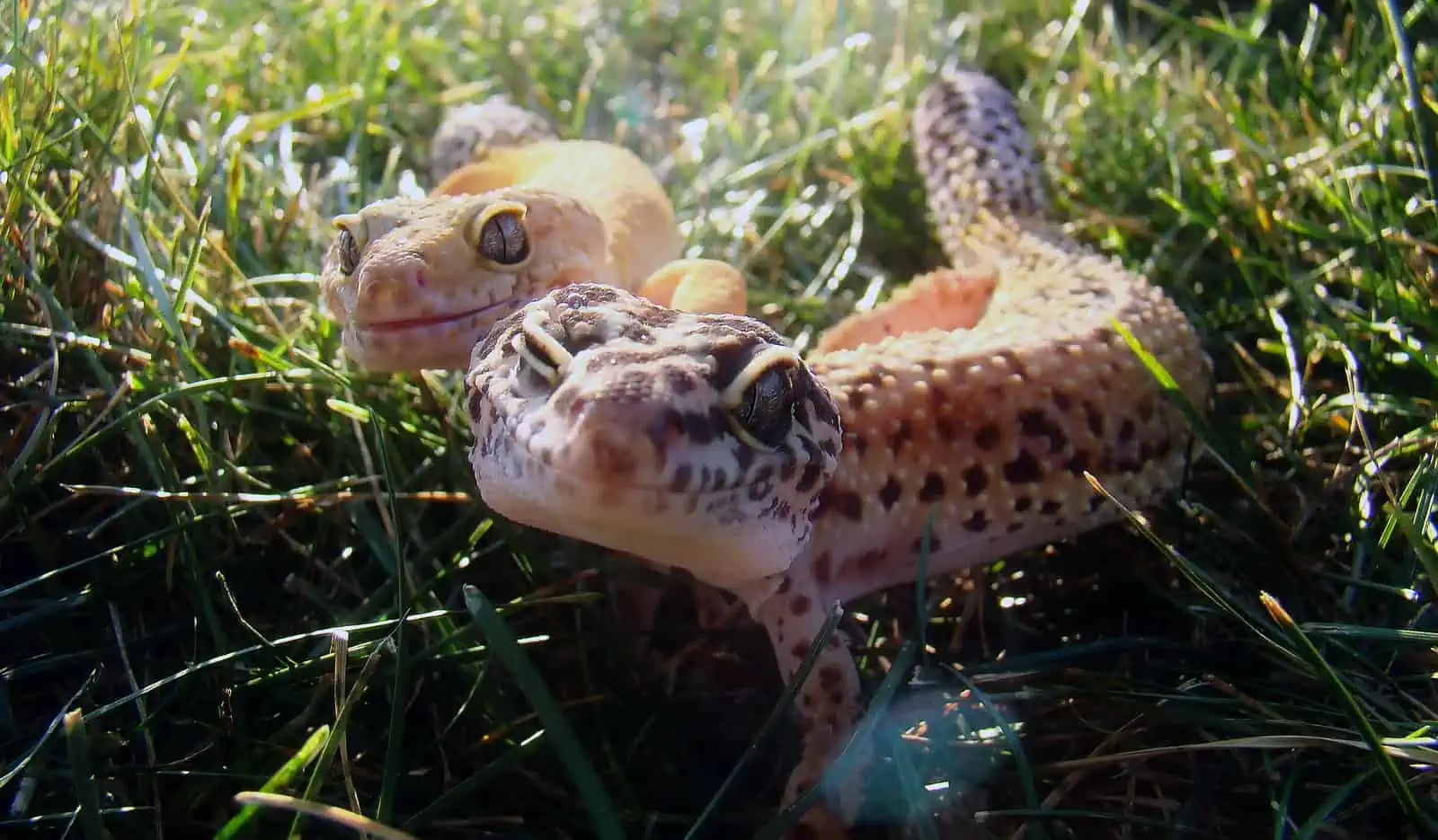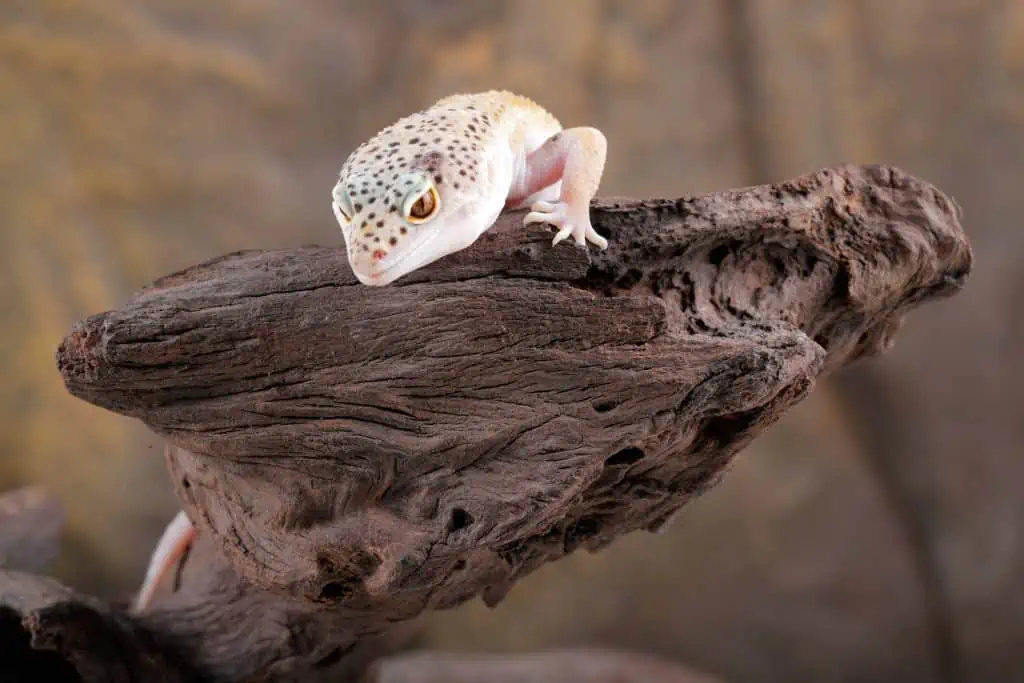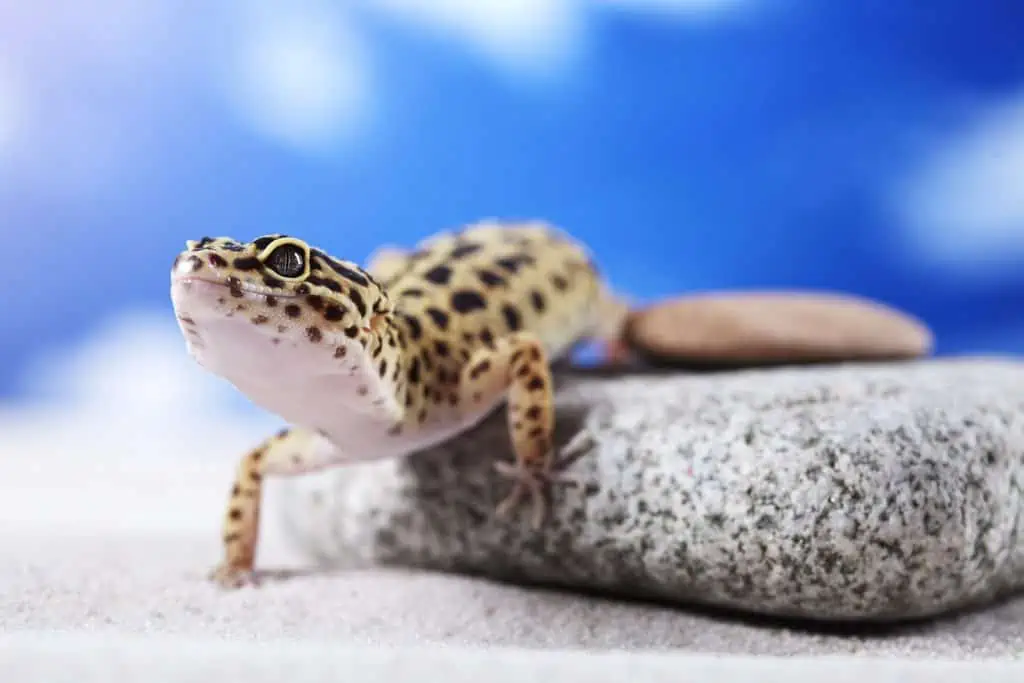When you feed, hold, and play with a leopard gecko, are you enjoying time with him or her?
While both male and female leopard geckos make equally good pets, knowing if your leo is a female or a male is still important. It will help you take better care of your pet, make breeding plans, and pick the right name for the smiling lizard.
Since leopard geckos don’t have obvious sex differences (nor wear clothes or make-up – but would it matter anyway?), telling the sexes apart at a glance is nearly impossible.
Fortunately, making a difference via certain minuscule but noticeable physical features is easy – once you know where to look.
By following our guide, you’ll become a leopard gecko sexing expert in no time!
Why Is It Important To Know The Sex Of Your Leopard Gecko?
Knowing if your leopard gecko is a male or a female is important for various reasons.
- Naming. The first and the most obvious reason you want to know the sex of your pet is to give it either a boy or a girl name. Although there are plenty of fun and exciting unisex names for leopard geckos, most owners want the name to reflect their lizard’s sex, along with other traits.
- Breeding. If you plan to breed your leo, you definitely want to know its sex to make plans for pairing and obtaining another male or a female.
- Temperament and health expectations. Males and females have different metabolisms; to observe if your leo is healthy, you should know what to expect from its behavior. For example, males can become nervous, aggressive, and lack appetite at the start of the breeding season. Females may stop eating when ovulating and carrying eggs.
- Leopard Gecko Gender Reveal Party. Just kidding 🙂
At What Age Can a Leopard Gecko Be Sexed?
Unfortunately, you can’t physically determine the sex of a leopard gecko baby. The hatchlings don’t have any visible sexual differences whatsoever.
The only way to guess a baby leopard gecko’s sex is to know its incubation temperatures.
To properly sex a leopard gecko, you’ll have to wait until the animal is at least six months old or about 5 to 6 inches long.
The good news is that from then on, sexing is relatively easy and doesn’t require any instruments or tools – just a keen eye.
What Methods Can You Use to Sex Your Leopard Gecko?
You can lean on two, potentially three, strategies to determine a leopard gecko’s sex.
The first one is straightforward and reliable. It’s looking out for the physical differences between males and females – scientifically known as sexual dimorphism.
The other one is more of a guess and relies on knowing the egg incubation temperatures.
Sexual development in leopard geckos is temperature dependent and follows this pattern:
- Eggs incubated at 80 degrees F – 100% of babies are female.
- Eggs incubated at around 87 degrees – equal chance of male and female development.
- Eggs incubated at 90 degrees – 98% of babies are male.
Suppose the breeders are reliable and have incubated the eggs at the ends of the temperature range (they usually do this purposefully to produce males or females). In that case, they’ll be able to tell you if a hatchling might be a baby boy or a baby girl. However, you’ll need to confirm this by regular sexing (described below) when the lizard matures a bit.
What Do I Have to Have in Mind Before Sexing My Leopard Gecko?
Before determining whether you’ll be painting your leopard gecko tank blue or pink (just joking), you have to know the leopard gecko sex differences in advance – any hold-ups to learn “on the way” can cause unnecessary stress for your leo.
So, let’s start learning!
Physical Differences Between Male and Female Leopard Gecko – Sexual Dimorphism
Leopard geckos aren’t sexed by their color patterns or apparent features. There is a slight difference in body size between adult males and females, but it’s impractical to use it for sex since body size changes and is highly individual.
The only way to sex a leopard gecko is to look at the tail’s underside.
On the underside of the body, and especially near the cloacal opening (or simply the vent), males have discrete but distinct structures that give away their sex.
Behavioral Differences? Tail Vibration in Males
This method is not a true sexing method but a way to help find a male gecko in a crowd. That way, you avoid losing time on sexing many leos before finding a male.
If there is a bunch of young leopard geckos together in the tank, watch them for a while and see if any of them vibrate their tails at other geckos. These are more likely to be males.
Of course, you have to confirm that it’s a boy through the regular sexing described above.
How To Determine Leopard Gecko Sex (In 5 Steps)?
Here are 5 steps to successfully determine the sex of the leopard gecko.
Step 1: Choose the right spot
Pick a spot that is well-lit and has a soft surface underneath where you’ll be viewing in case it escapes your grip and falls down.
Low light conditions will require additional time for your eyes to focus on the differences, and sexing should be done as quickly as possible to avoid struggle and stress.
Step 2: Prepare a Reference
If you are new at this, it is highly helpful to have another, properly sexed leo to notice the difference easier.
If not, prepare some clear images of leopard gecko sex differences in advance.
Step 3: Pick Up the Gecko Carefully
Now, you’ll have to pick up the leopard gecko so you can look at its underside.
This is the most delicate part of the entire process; if the gecko is used to handling, this step will probably be smooth, but most juveniles aren’t so tame yet. That is why you have to hold the lizard firmly but gently during the procedure.
Avoid sexing your leopard gecko right after a meal to avoid food regurgitation.
How To Pick Up A Leopard Gecko For Sexing?
First and most important: never take the gecko by the tail, and don’t grab the tail if he or she struggles to escape. A stressed leopard gecko can drop the tail if you grab it, so don’t risk it.
The best type of hold is to keep the middle of the gecko’s body firmly but gently in your hand. You want to sightly restrain the lizard, but without struggle or squeezing (ever). Of course, the devil’s in the details.
- The head and the neck will be out of the hold but loosely supported and controlled by your thumb and index finger; the front legs rest on the index finger.
- The part your looking at should also be outside of your grip, near the outer side of your pinky.
- Use the other hand to support the leo’s hind legs – if you leave them hanging, chances are he’ll panic.
- Slowly lift the gecko up at a slight angle so you can view the vent. Avoid turning the gecko upside-down (unless the gecko is really tame or you’re really experienced).
Some squirming is fine, but If the leopard gecko panics and starts squirming like he’s fighting for his life, don’t squeeze – let him go and try another time.
For the truly unruly individuals, an alternative could be to put a leo in a small empty glass tank and look at it from underneath.
Step 4: Look for the Sex Differences
The sexual dimorphism in leopard geckos is represented by the pre-anal pores, femoral pores, and hemipenal bulges in males.
Translation?
- Under the tail in front of the vent (on the belly side of the vent, that is), males have a series of small dots lined in a V-shape. These are the pre-anal pores.
- Behind the vent (on the tail side), there are two symmetrical bulges on each side of the tail. They’re an outline or the “pockets” containing the two hemipenes – leopard gecko male sexual organs.
- Males also have enlarged pores on the undersides of their hind legs – the femoral pores.
Female leopard geckos have no such structures – both the front and the back of the vent are smoother, and there are no large pores on the hind legs.
Step 5: Return the Gecko to its Tank
After completing the sexing, and especially if it has been visibly stressful, don’t try to “comfort” the gecko or do anything else with him – just return him to the tank to relax.
It’s Your Turn!
I hope you’ve learned something new about leopard gecko sex differences and enjoyed the reading.
As you can see, once you know what you’re looking for and where, telling if your leopard gecko is a gentleman or a lady becomes easy.
Remember – careful handling is the number one concern when sexing leopard geckos; other steps are quite straightforward.
Do you know someone who would find the article useful? Feel free to share it!
Also, we love to hear from the community, so if you have any questions or doubts – drop a question below!




